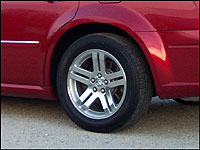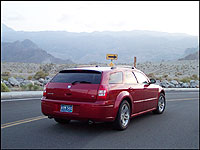What makes it so good? It's a combination of the premium-level aluminum suspension parts and the way Dodge, a company that has a race-winning history with the Viper, naming one, has optimized them. The modified E-Class architecture is comprised of an independent short/long arm (SLA) setup in the front and 5-link independent configuration out back. When push comes to shove the Magnum is ideally damped
 |
| Premium-level aluminum suspension parts and a winning race history have given Dodge the tools to give the Magnum an amazing ride coupled with stellar handling. The Jeff Gale designed 18-inch RT rims are pretty stunning too. (Photo: Trevor Hofmann, Canadian Auto Press) |
over uneven pavement or when transitioning lane to lane, showing its weight but never becoming unsettling, while delivering excellent control through long sweeping or tight "S" curves at high-speed, plus it's completely composed during extreme braking.
The brakes are an important part of that last equation. For wheel discs are standard, as is a 4-channel ABS system on RT models.
 |
| Also borrowed from Mercedes-Benz is the Magnum's rack-and-pinion steering system. (Photo: Trevor Hofmann, Canadian Auto Press) |
The power-assisted, speed-sensitive, rack-and-pinion steering rack is also a Mercedes-Benz derived unit, and performs almost flawlessly. My only complaint has nothing to do with how Dodge engineered it into the Magnum, but seems to be an inherent problem with the rack when fixed to the outgoing M-B E Class as well. Under extreme cornering on choppy road surfaces, and I mean extreme cornering, the steering wheel will buck from side to side about a half to one inches or so. It's a little disconcerting, but if held in place doesn't affect the drivability of the car. The wheels still stay planted, and the car still takes the corner better than the majority of its competitors.

